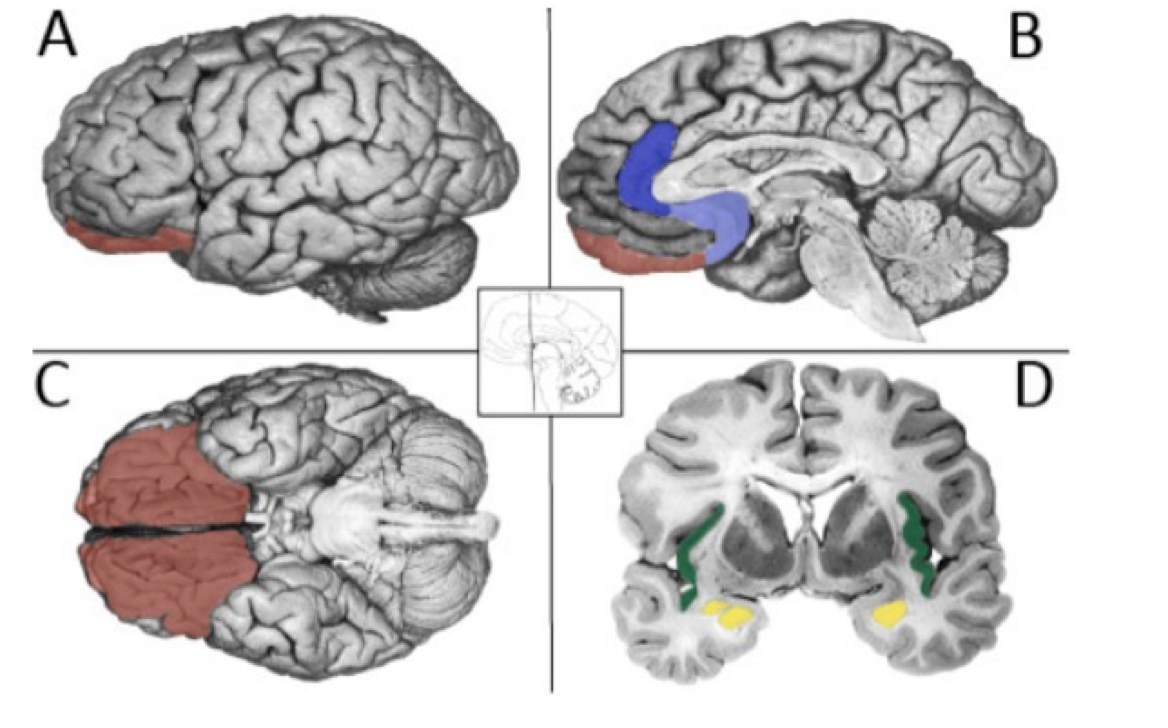Chapter 7: Physiological Measures of Emotion
Locationist and One-Network Views of Emotions in the Brain
Currently, two views exist on the relationship between the brain and emotional experiences. The goal of the locationist perspective (see Figure 7) is to identify specific brain areas responsible for specific emotions. Basic emotions researchers support the locationist perspective. The one-network view believes that a one-to-one mapping of specific emotions and brain structures does not exist. Instead, one-network theorists look for emotional networks that operate during an emotional experience. Social constructivist support the one-network view. First, we will review evidence for the locationist perspective, followed by the one-network perspective.
Locationist Perspective
There are many sub-theories of the locationist perspective, and they differ on the emotions posited to activate various parts of the brain. One theory suggests that the amygdala, insula, orbitofrontal cortex (OFC) and anterior cingulate cortex (ACC) are activated during specific emotional experiences. Work has found that the amygdala is activated during experiences of fear, anger, and disgust, and somewhat for positive emotions. The insula is activated for disgust and amusement. Although these two emotions seem quite different, some research shows that when we hear about something disgusting (like a joke) we in turn laugh (which would be amusement!). The orbitofrontal cortex is associated with anger and identifying anger facial expressions (so, possibly experiencing fear). The anterior cingulate cortex is linked with pain, sadness, loneliness, and also fear. Finally, the basal ganglia is part of the reward system and contains large amounts of dopamine. Thus, the basal ganglia is often associated with positive emotions. Figure 7 displays the locationists’ hypotheses of brain structures that are linked to specific emotions. There does seem to be some connection between specific emotions and brain structures, but also different emotions activate the same structure. So, this might suggest structures could be linked to general valence (negative or positive), but not necessarily categorical emotions (anger or fear).
Figure 7
Locationist Perspective of Brain

Table 1
Description of Color Coded Areas in Figure 7
| Color | Brain Structure | Activated for Emotion.. |
|---|---|---|
| Yellow | Amygdala | Fear |
| Green | Insula | Disgust |
| Brown | Orbitofrontal Cortex (OFC) | Anger |
| Blue | Anterior Cingulate Cortex (ACC) | Sadness |
Reproduced from “The brain basis of emotion: a meta-analytic review,” by K.A. Lindquist, T.D. Wager, and H. Kober, E. Bliss-Moreau, and L.F. Barrett, 2012, The Behavioral and brain sciences, 35(3), p. 53 (The brain basis of emotion: A meta-analytic review). Copyright 2011 by the Cambridge University Press.
Long Description
This image presents four anatomical views of the human brain, each highlighting specific regions, primarily in the temporal lobes:
- Image A (Top-left):
A lateral view of the left hemisphere, showing a red-highlighted region in the temporal lobe. - Image B (Top-right):
A medial view of the right hemisphere, with two highlighted regions in the temporal lobe—one in red and another in blue. - Image C (Bottom-left):
An inferior (bottom-up) view of the brain, showing red-highlighted regions in the temporal lobes of both hemispheres. - Image D (Bottom-right):
A coronal (frontal cross-section) view, displaying bilateral structures with regions highlighted in green and yellow.
These views are likely used to illustrate functional or anatomical areas of interest in neuroscience or neuroimaging studies, particularly within the temporal lobes.

